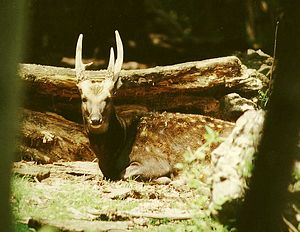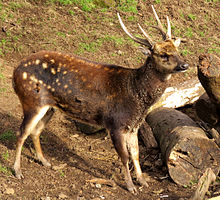Prince Alfred Hirsch
| Prince Alfred Hirsch | ||||||||||||
|---|---|---|---|---|---|---|---|---|---|---|---|---|

Prince Alfred Hirsch ( Cervus alfredi ) |
||||||||||||
| Systematics | ||||||||||||
|
||||||||||||
| Scientific name | ||||||||||||
| Cervus alfredi | ||||||||||||
| Sclater , 1870 |
The Prince Alfred deer ( Cervus alfredi or Rusa alfredi ) is a species of mammal from the deer family (Cervidae). The species endemic to the Philippines is named after Prince Alfred , son of the British Queen Victoria and is one of the rarest deer species in the world. In the Visayas the names Usa and Lagsaw are used for the Prince Alfred deer.
features
The fine, extremely dense fur of this deer is dark brown in color. Characteristic are the light spots that extend along the back and the flanks and get smaller towards the front. The underside of the body and tail are colored whitish-gray. The antlers , which, as with almost all deer species, are only worn by the males, are relatively short and thick. Its narrow skull compared to other deer is striking. With a head body length of around 125 centimeters and a shoulder height of 65 to 80 centimeters, it is one of the smallest representatives of the real deer .
distribution and habitat
Prince Alfred deer live in the rainforests of the Visayas Islands, part of the Philippines. They are extinct on many islands in their original range, including Cebu , Bohol and Masbate . The populations on Leyte and Samar, which were still recorded in the 1980s, are likely to have died out, so that the species is now only found in isolated places on the island of Negros , around the volcanoes Mandalagan , Cuernos de Negros , Silay , and in the western wooded Central- Panay Mountains on Panay Island .
Way of life
Little is known about the way of life of the Prince Alfred deer. They are nocturnal and live mostly solitary. They prefer to stay in dense undergrowth and feed on grass and leaves. Most births occur in May and June, the gestation period is around eight months and the litter size is usually a single young.
threat
Hunting and widespread destruction of its habitat have brought the species to the brink of extinction. As mentioned above, it occurs today only in isolated areas on two islands and has thus lost more than 95% of its original range. It is estimated that there are only a few hundred members of this species left; the IUCN lists them as endangered . Through breeding programs and more effective monitoring of the protected regions, attempts are being made to prevent a further decline in the population. The national parks and nature parks on Negros in which the Prince Alfred Hirsch lives, the Balinsasayao Twin Lakes Natural Park , the Northern Negros Natural Park and the Mount Kanlaon Natural Park have been incorporated into the Integrated Biosphere Zones Act for the Protection and Conservation of the Biosphere (NIPAS) recorded. The Zoological Society for Species and Population Protection (ZGAP) together with the Talarak Foundation Inc. have successfully set up breeding groups in several breeding stations, including on Negros, since 2014, which form the basis for future resettlement projects. The ZGAP has been trying to preserve the highly endangered deer species since the late 1980s.
Systematics
The Prince Alfred Hirsch was first scientifically described by Philip Lutley Sclater in 1870 . It was the provisional description of a new addition to the menagerie of the Zoological Society of London , which was listed in a corresponding list. Sclater was unsure about the origin of the specimen and named the Malay Peninsula and surrounding islands as a possible distribution area. Richard Lydekker corrected this in 1915 and gave Manila as the actual place of origin of the type specimen.
The Prince Alfred deer has only been listed as a separate species since the 1980s; it used to be considered a subspecies of the Sambar or the Philippines deer . Recent molecular genetic studies confirm the close relationship with the Philippines deer, but the Prince Alfred deer is possibly only a subspecies of the latter.
supporting documents
- ↑ Roland Wirth: Finally progress in the maintenance project for the Prince Alfred Hirsch. ZGAP Mitteilungen 6th year, issue 2, 1990, pp. 1–3
- ^ Philip Lutley Sclater: The Secretary on Additions to the Menagerie. Proceedings of the Zoological Society of London 1870, p. 381 ( full text )
- ^ Richard Lydekker: Catalog of the ungulate mammals in the British Museum (Natural History). London, 1915, pp. 1–438 (pp. 62–63) ( online )
- ↑ Nicola S. Heckeberg, Dirk Erpenbeck, Gert Wörheide and Gertrud E. Rössner: Systematic relationships of five newly sequenced cervid species. PeerJ 4, 2016, p. E2307 doi: 10.7717 / peerj.2307
literature
- Ronald M. Nowak: Walker's Mammals of the World . The Johns Hopkins University Press, Baltimore 1999, ISBN 0-8018-5789-9 .
- Don E. Wilson, DeeAnn M. Reeder (Eds.): Mammal Species of the World . 3rd edition. The Johns Hopkins University Press, Baltimore 2005, ISBN 0-8018-8221-4 .
Web links
- ZGAP projects
- Distribution map and further information
- Information on Animal Info
- Rusa alfredi in the endangered Red List species the IUCN 2006. Posted by: Deer Specialist Group, 1996. Accessed on 12/03/2006.


